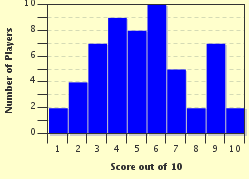Quiz Answer Key and Fun Facts
1. In the New American Standard Bible, in the Gospel of John (Ch. 20), on the Sunday after Jesus' death, Mary Magdalene went to the tomb of Jesus where she saw a person who she supposed to be the gardener. He asked her why she was weeping. She did not directly answer, but said "Sir, if you have carried Him away, tell me where you have laid Him, and I will take Him away." The person to whom she spoke said "Mary." What did she reply?
2. The Gospel of John tells of Jesus Christ's resurrection a little differently than the other Gospels of Matthew, Mark, and Luke do. Using the NASB, which of these is NOT true about John's Gospel?
3. John 21 states that the resurrected Jesus appeared to Peter, John, and other disciples, but at first they didn't know it was Him.
After they found out it was Jesus, He asked Peter a question. According to verse 15, what essentially did Jesus ask Peter?
4. Luke tells how Jesus appeared to the disciples "But they were startled and frightened and thought that they were seeing a spirit". Jesus showed the wounds in His hands and feet but they STILL couldn't believe it was Him. What else did Jesus do to show it was really Himself?
5. Luke 24:4-7, in the New American Standard Bible, states that Jesus appeared to Mary Magdalene, Joanna, James's mother named Mary, and other women. Jesus spoke to them and said, "Why do you seek the living among the dead? Do you not remember that I told you all that the Son of Man would rise on the third day?"
6. According to Matthew 28, what was the chief priests' reaction to the guard's report of the events surrounding the resurrection?
7. In the 24th chapter of Luke, the resurrected Jesus appeared to two men as they were on a journey from a place called Emmaus. Jesus drew near and walked with them, not revealing who He was. As the men journeyed, Jesus began to expound the scriptures to them, from Moses and all the prophets things concerning Him. One of the men was named what?
8. But wait! Perhaps Jesus IS the gardener! Isaiah 5 says, "For the vineyard of the LORD of hosts is the house of Israel, And the men of Judah His delightful plant." In Mark Chapter 11, Jesus cursed a fig tree because it bore no fruit, and it withered and died. In the same chapter He tells of a vineyard owner telling the gardener to cut down a fig tree because it was not producing fruit. So we go from owner of a vineyard regarding Judah as his crop, to the killing of a barren tree by Jesus, and the impending death of a barren tree via the gardener in a parable. Pulling all of these together, we read in Luke 19 (NASB) that Jesus wept over the impending death of who or what?
9. Mary Magdalene has been called "The Apostle to the Apostles" because of the events found in the Gospel of John, Chapter 20. Based on one part of the definition of an apostle as "one sent on a mission, or a messenger," which part of this Gospel chapter (NASB) gives reason for her title?
10. According to 1 Corinthians 15, what is the Christian faith without Jesus Christ's resurrection?
Source: Author
Ceduh
This quiz was reviewed by FunTrivia editor
looney_tunes before going online.
Any errors found in FunTrivia content are routinely corrected through our feedback system.

